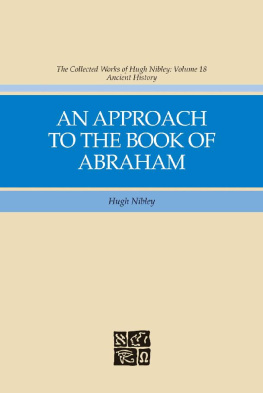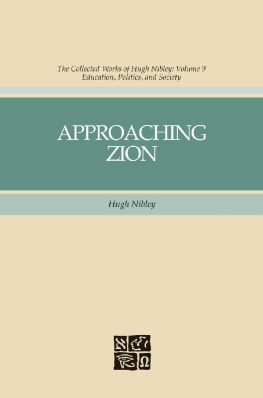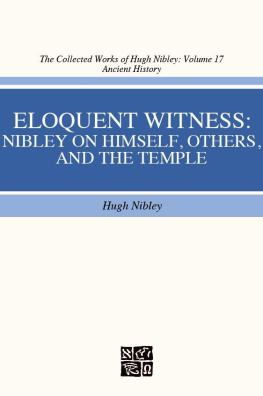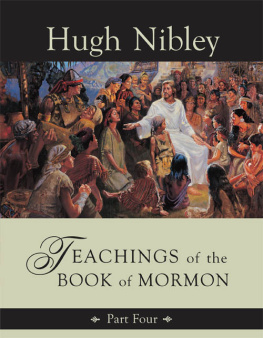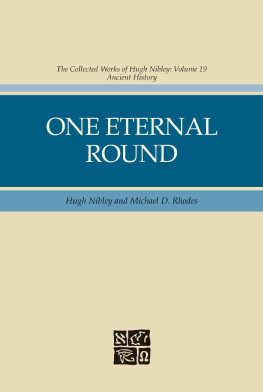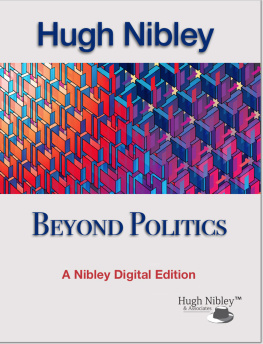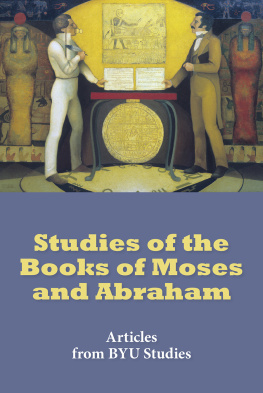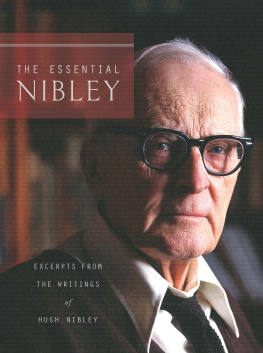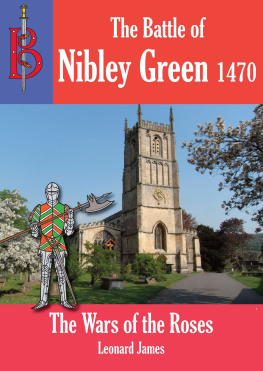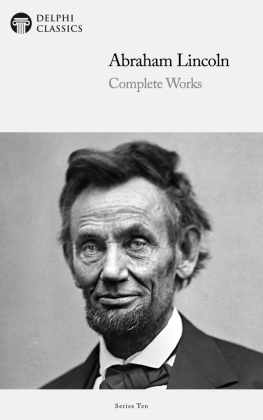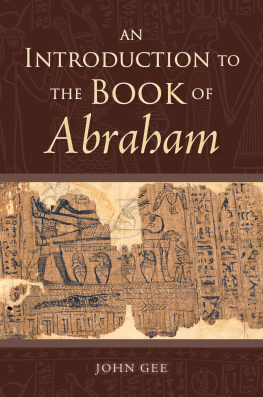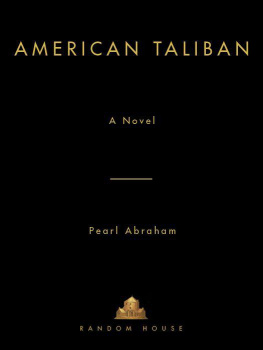2010 The Foundation for Ancient Research and Mormon Studies and Hugh Nibley and Associates, LC
All rights reserved. No part of this book may be reproduced in any form or by any means without permission in writing from the publisher, Deseret Book Company, P O. Box 30178, Salt Lake City, Utah 84130. This work is not an official publication of The Church of Jesus Christ of Latter-day Saints. The views expressed herein are the responsibility of the author and do not necessarily represent the position of the Church, of Deseret Book Company, of the Foundation for Ancient Research and Mormon Studies, or of the editors.
DESERET BOOK is a registered trademark of Deseret Book Company.
Visit us at deseretbook.com
Contents
Illustrations
Lucy Mack Smith portrait with Facsimile 1 in background
JSP I mounted on backing
Detail of Lucy Mack Smith portrait
Facsimile 2, Church Historians copy
Facsimile 2, Hedlock engraving
Meux hypocephalus
Franklin S. Spalding
Facsimile 1, July 1842 Millennial Star
JSP VI, swallow vignette
JSP III, judgment scene
JSP I, 1842 and 1907 versions of Facsimile 1
Myers and Nash hypocephali
Facsimile 2 and Vienna hypocephalus
Double-headed figures
Two birds over a lion couch
JSP I, detail of Abrahams hands
Egyptian canonical drawing of hands and thumbs
Lion-couch scenes at Philae
Close parallel to Facsimile
Egyptian canonical drawing of figure with guidelines
Pharoah on lion couch, shrine of Opet
Chaldean bed on Assyrian bronze amulet
Persian-style lion-paw throne leg and Darius on lion-footed chair
Old Kingdom lion altars and couch
Ivory headrest, lion couches, tomb of Tutankhamun
Bed of Osiris and altars
Archaic funeral rite
Conception, birth, and nursing of Hatshepsut on lion couches
Temple of Opet at Karnak
Flint knives
Mummy of Osiris on back of crocodile, Philae
Ba -bird
Hawk delivers Osiris in lion-couch scenes
Facsimiles 1, 2, 3 in sequence
Temple of Opet, three rooms
Busiris and Heracles
Facsimile 1, Facsimile 2, JSP III, four canopic figures
Four sons of Horus as deities
Four birds to the four corners
Louvre N 3525 hypocephalus, four-headed ram
Four sons of Horus chart
Four nations of man, tomb of Seti I
Northern polar stars (2000 B.C., A.D. 2000)
Gold vessel with four lotuses, tomb of Nebamun
Nefertem lion as guard, Philae
Passport approval by Khnumhotep
Saqqara panels and pillars
Pylons and niches as pillars of heaven
Ramses III on pillars of heaven
Philip Arrhidaeus on pillars of heaven
Crocodile surrounded by zigzags
Zigzag lines as expanse of the heavens
Zigzag lines as water, tomb of Ramses IX
Zigzag lines as firmament and waters of life
Herman Witsiuss Aegyptiaca and William Haless Chronology
Shrine to sun-god of Pharaoh Niuserre
Map of Mesopotamia and Egypt
Metternich Stela
Facsimile 1
Facsimile 3
Kirtland Egyptian Papers
Egyptian Manuscript #1
Egyptian Manuscript #3
Egyptian Manuscript #4
Egyptian Manuscript #6
Egyptian Manuscript #7
Book of Abraham Manuscript #2
Book of Abraham Manuscript #3
Book of Abraham Manuscript #1
Book of Abraham Manuscript #4
Key to Abbreviations
AfO Archiv fr Orientforschung
ASAEAnnales du service des antiquits de lgypte
BDBook of the Dead
BEBibliothque gyptologique
CdE Chronique dgypte
CT Coffin Text, as appearing in Adriaan de Buck, The Egyptian Coffin Texts
CWHN The Collected Works of Hugh Nibley
IE Improvement Era
IFAOInstitut franais darchologie orientale du Caire
JEAJournal of Egyptian Archaeology
JEOLJaarbericht van het Vooraziatisch-Egyptisch Genootschap (Gezelschap): Ex oriente lux
JNESJournal of Near Eastern Studies
JQRJewish Quarterly Review
JSPJoseph Smith Papyrus (Papyri)
MDAIK Mitteilungen des deutschen archologischen InstitutsAbteilung Kairo
MIFAOMmoires publis par les membres de linstitut franais darchologie orientale du Caire
MMAFMmoires publis par les membres de la Mission archologique franaise du Caire
PG J.-P. Migne, ed., Patrologiae Cursus Completus: Series Graeca, 162 vols. (Paris: Garnier, 185786)
PL J.-P. Migne, ed., Patrologiae Cursus Completus: Series Latina , 221 vols. (Paris: Garnier, 184464)
PO Franois Nau and Ren Graffin, eds., Patrologia Orientalis (Paris: Librarie de Paris, Firmin-Didot, 1903 )
PTPyramid Texts
RdERevue dgyptologie
REJRevue des etudes juives
RTRecueil de travaux relatifs la philologie et larchologie gyptiennes et assyriennes
TB Babylonian Talmud
UGAKurt Sethe and Hermann Kees, eds., Untersuchungen zur Geschichte und Altertumskunde gyptens, 15 vols. (Leipzig: Hinrichs, 18961939)
Urk Urkunden des gyptischen Altertums
Wb Adolf Erman and Hermann Grapow, Wrterbuch der gyptischen Sprache
ZSZeitschrift fr gyptische Sprache und Altertumskunde
Editors Introduction
Hugh Nibley and the Joseph Smith Papyri
The title for this work, An Approach to the Book of Abraham , is an adaptation of one of Hugh Nibleys works on the Book of Mormon, An Approach to the Book of Mormon . a work that heavily influenced Nibleys approach in several of the studies included in this book. These studies reflect Nibleys early attempts to grapple with the Book of Abraham and the Joseph Smith Papyri. They still remain important discussions of things that must be understood before one can profitably discuss or study the Book of Abraham and its relationship to the Joseph Smith Papyri.
Nibleys work on the Joseph Smith Papyri and the Book of Abraham spanned four decades, resulting in an average of one book per decade. This book comprises mainly the preliminary studies of the first decade, the 1960s. First published in the middle of the 1970s, The Message of the Joseph Smith Papyri an edition, translation, and largely Egyptological commentary of Joseph Smith Papyri X and XImarks the second decade. revisiting and clarifying what he said on the subject earlier. After that time, up until about the time of his death, Nibley worked on what he came to call One Eternal Round . He turned the manuscript over to the editors on 10 October 2003. The manuscript filled four rooms in his house and totaled 31 file boxes. Additionally, there were nearly 650 electronic files of drafts of chapters and outlines. On 23 February 2005, the day before he died, it was decided in Nibleys presence that Michael Rhodes would edit and complete Nibleys work on the volume. If the delay seems long (publication is scheduled for 2010), at least the reader has some idea of what Rhodes has been up against.
For Latter-day Saints, Nibleys decades-long work on the Joseph Smith Papyri has made his name almost synonymous with the subject. Nibleys involvement with the papyri is not something that seems intuitive from his publications at the time the papyri were made available to the Church in late 1967. His academic work to that point had concentrated on the Roman world of the fourth century A.D. as well as on early Christianity. A historian trained in Classics is not an obvious choice to elucidate the meaning of a handful of Ptolemaic Egyptian papyri in hieratic. To see why Nibley was the only man for the job, one needs to know something of Nibleys preparation during the decade or so before.
Nibley and Things Egyptian
Hugh Nibley had tried to study Egyptian when he was a graduate student at the University of California at Berkeley in Classics and history. The Egyptian expert there at the time was Henry Lutz, who was of the generation of orientalists who studied everything about the ancient Near East and dabbled in all the languages. Lutz and Nibley were not on good terms when Nibley was a student because Lutz did not like Mormons. Nibley took most of his Near Eastern language courses in Hebrew and Arabic from William Popper. Nibley tried to teach himself from the then recent first edition of Alan Gardiners classic Egyptian Grammar.
Next page
